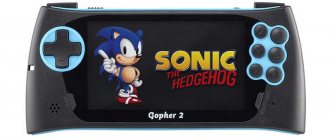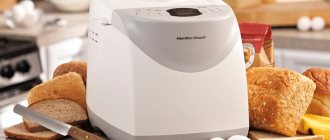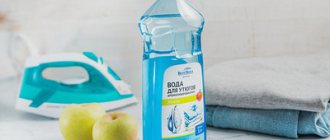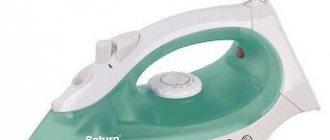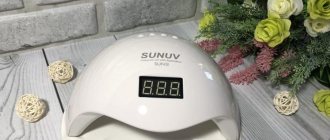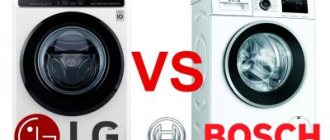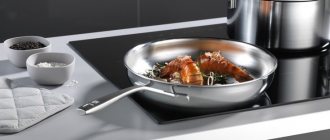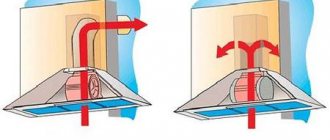An iron is a fire hazard, and we have already written about this in detail. If used incorrectly, it can burn through the fabric, or even the ironing board, stick to clothes so that you cannot remove it, and over time it becomes covered with soot, which happily melts into your white shirt. Modern manufacturers are struggling with the problem by creating new sole material - the very part with which we iron. In this article, we will try to figure out which sole it is better to choose an iron with, so that things suffer as little as possible.
Of course, it would be useful to remind you: follow the ironing recommendations indicated on the product tag, and try to choose the proper temperature setting suitable for the fabric you are ironing.
- Which sole is considered the best?
- Aluminum: cheap and very cheerful
- Stainless steel: strong and inexpensive
- Teflon: does not spoil things until the first scratch
- Ceramics and metal ceramics
- Titan: An Unexplored Innovation
Which iron sole is considered the best?
The requirements for sole material are not so great. A good material glides easily over the fabric (that is, it should be as smooth as possible), durable, heats up evenly and is gentle on clothing, while smoothing out wrinkles.
Modern irons can have the following soles: aluminum, stainless steel, Teflon, ceramics, cermet and titanium. In addition, there are proprietary alloys, such as Eloxal or Sapfir from Braun.
Let's try to consider each of them from the point of view of the requirements that the best sole material should have - and figure out what to take.
Titanium
Reviews about which sole it is better to choose an iron with suggest that the most durable (however, expensive) option is titanium coating. But we’ll talk about reviews in detail below, but for now let’s discuss the advantages:
- Highest level of strength;
- Non-stick;
- Long service life;
- Uniformity and speed when heating;
- Excellent glide.
Are there any disadvantages, is it worth buying such a device? Every technique has disadvantages, in this case these are:
- High price;
- Heavy weight.
We have prepared a small table that will help you understand what is better to choose?
| Material | Strength | Weight | Price | Slip | Non-stick |
| Aluminum | — | average | available | + | — |
| Stainless steel | + | heavy | average | + | + |
| Teflon | — | easy | available | — | + |
| Ceramics and glass ceramics | — | average | average | + | + |
| Titanium | + | heavy | high | + | + |
We studied the table of differences between iron sole materials, which is better and which is worse.
Let's look at some reviews from real users that will help you figure out which option is better for everyday use.
Aluminum: cheap and very cheerful
Aluminum is the first sole material for electric irons (before that they were made of coal and cast iron). It is a very light and soft metal that sands well, so aluminum soles are perfectly smooth.
In addition, this metal is almost instantly heated by electricity to the desired temperature. Therefore, many modern inexpensive irons have soles made of this material. For example, this Philips Azur, which we cited as an example:
However, that's where the benefits end. Due to the softness of aluminum, the soleplate is very easy to scratch, and damage reduces the quality of ironing. In addition, it is this metal fabric that can be “smoothed” to a shine that no amount of washing can remove.
By the way, modern manufacturers fight this with the help of a special aluminum treatment - anodizing. If it is indicated that the sole is made using Careeza, Anodilium or Eloxal technologies, then that is what it is. This Braun iron has a patented Eloxal Plus sole:
But rapid heating has too many risks: if you set the temperature incorrectly, your silk blouse will instantly stick. Therefore, in the rating of sole materials for irons, aluminum is most likely at the bottom.
Aluminum
Irons with aluminum soles are the lightest. They heat up very quickly and cool down just as quickly. They glide perfectly on the material. Aluminum is highly polished, so these soles are perfectly smooth. The thin edge allows you to iron the thinnest and narrowest places.
But aluminum surfaces are not resistant to damage; aluminum is a soft metal. Over time, the sole becomes deformed; such a defect cannot be corrected; you will have to buy a new iron.
After ironing with an iron with a pure aluminum soleplate, a shine may appear on the item. To prevent this from happening, manufacturers use anodizing. An oxide film appears on the surface of the metal, which prevents smoothing.
Fast heating is good, but it also has a downside: if you set the temperature incorrectly, your delicate item will be hopelessly damaged.
Stainless steel: strong and inexpensive
The most popular iron sole material is stainless steel. Strength and resistance to corrosion allow it to be considered one of the most successful materials for the soles of irons, especially steam ones.
In addition, steel smoothes out any wrinkles well without “smoothing”, and also heats up quite quickly. This is again both a plus and a minus - as soon as you forget the iron, sole down, on the ironing board, and behold, the board is already “fried.”
Irons with steel soles are quite heavy - this is not surprising, because steel has never been a light material. Although compact models weigh less than a kilogram, for example, this small Scarlett iron:
How gentle is stainless steel on fabric? Unlike aluminum, if the temperature is violated, it does not stick, but “leaves a burn” on the fabric. Of course, after this the item can also be considered hopelessly damaged, but the damage is still less - at least the iron will remain intact.
How to choose the right iron with a ceramic sole
Putting aside the popular materials for iron soles (stainless steel, aluminum, Teflon), you should pay attention only to ceramics or cermets. The ceramic soleplate of the iron ensures sufficient glide over the surface of the laundry. A similar effect cannot be achieved using devices with other materials.
Advantages of ceramics:
- Not only does the sole warm up quickly, but it also retains heat for a long period of time. Because of this quality, such devices are very economical in energy consumption.
- The surface is easy to clean, but only with the use of special products. They not only soften the dirt, but also protect the sole from minor abrasions and scratches.
- Of all types of irons, only ceramic ones have the highest slip coefficient. Therefore, the quality of ironing also improves.
A metal-ceramic device is not too different from ceramics, but its service life is increased. Adding a metal component to the base of the iron pad reduces the fragility of the material. The remaining qualities are completely similar to ceramic products.
The time has long passed when the iron was a pound piece of steel that had to be placed on an open fire to heat it up. Now, in addition to their main function, these home tools are capable of performing a host of others.
Additional functions that modern irons provide:
- Includes a nozzle for delicate ironing. A very useful addition to the iron, which allows you to iron thin and expensive fabrics such as silk. It is a plate, shaped like the sole of the iron, which is attached to the bottom of the device using special clamps. The main function is to prevent the temperature from exceeding the permissible limit.
- Hot steam function. Installed on almost all modern devices. Very convenient to use when ironing dry laundry. Steam is supplied to the surface of the laundry through special holes in the sole of the household tool. The quality of ironing is affected not only by the diameter of these holes, but also by their number and location. Some models may have a regulator installed that will help you adjust the steam wave to suit any type of laundry.
- Spray. It is installed at the top of the iron and is a small device that, when you press a button, releases a stream of water. It is convenient to use when ironing those types of fabric that are undesirable to be treated with steam.
Which sole is better, what functions an iron can have, was described above. The following is a rating of irons for 2021 with short reviews of only the best models.
Teflon: does not spoil things until the first scratch
The only difference between these irons is the coating: a non-stick layer is applied to an aluminum or steel sole. Everyone knows the advantages of Teflon frying pans: it is extremely difficult to burn anything with them when cooking. This also applies to irons, so a Teflon iron can be called gentle on fabric.
The Teflon coating is smooth and glides easily. Teflon on aluminum is less effective at smoothing out wrinkles than on metal. So if you buy a Teflon iron, then on a metal backing, for example, like this:
But where the disadvantages of Teflon are hidden is in its poor resistance to contact with metal parts. By analogy with Teflon frying pans, the sole of a Teflon iron is easily scratched and immediately loses its non-stick properties, and things begin to “burn”. In addition, it is these models that especially “love” to become covered with soot. Fortunately, with most modern models it can be washed off with a regular rag.
But there is good news: Teflon irons include Braun irons with Sapfir coating. Sapfir soles are made of a stainless alloy, onto which a special coating of corundum powder is applied, which is akin to sapphire (sapphire chips are a marketing ploy). Thanks to this, they not only acquire non-stick properties, but also significant resistance to damage. If you are wondering which iron coating is better, then Sapfir is at least close to ideal. For example, this Braun iron has just such a sole:
Teflon
You didn’t think that this material was only used in the production of frying pans, did you? And rightly so, this is an excellent option for other types of household appliances.
The characteristics of the coating are very similar to those of aluminum:
- Easy to glide;
- The material is ironed perfectly.
Disadvantage: prone to scratches.
But the main difference between Teflon and its analogues is its absolute non-stick properties. This property guarantees:
- Easy cleaning;
- Inability to cauterize tissue.
We haven’t finished choosing which soleplate is best for the iron – read our review further.
Ceramics and metal ceramics
Ceramic or metal-ceramic coating of the sole is quite popular. Customers like ceramic soles based on the same principle as Teflon ones: nothing sticks to ceramics.
Ceramic irons provide easy gliding, while metal-ceramic irons also provide high quality ironing due to a heavier sole. The corresponding models are not very expensive. This Galaxy iron will cost less than a thousand:
However, ceramics is an even more fragile material than Teflon. Both it and metal ceramics require very careful handling. Any damage - for example, dropping an iron - or a scratch quickly leads to peeling of the ceramic coating, and with it, “burns” on the clothes.
In addition, carbon deposits also form on ceramics, and they are so corrosive that removal requires a special cleaner for irons. An exception was invented by Tefal - the Ultragliss Diffusion sole, which can be cleaned with a regular damp cloth:
Stainless steel
Stainless steel is not inferior in popularity to ceramics. Among its obvious advantages are the following:
- Strength and wear resistance;
- Resistance to damage and corrosion;
- Fast and even heating;
- Excellent sliding properties on fabric;
- Low cost.
The only but significant drawback of such an iron is its heavy weight.
Despite the excellent characteristics of this coating, manufacturers are trying to make it even better. Thus, models are popular in which chrome or sapphire is applied to the base, which helps protect the sole from corrosion and extends the service life of the iron. Naturally, the cost of such equipment will be higher than that of conventional stainless steel irons.
Considering that irons made of ceramics or stainless steel are the most popular among consumers, many buyers do not know which material is best to choose. In this case, you need to take into account the volume of ironing. If you iron often and a lot, it is better to choose a more practical stainless steel option.
Pros and cons of non-stick iron coating
When choosing a non-stick coating, you need to pay attention to the fact that it has the following properties:
- glides easily across the fabric;
- heated evenly;
- had little weight;
- was resistant to mechanical damage;
- did not leave dark marks on things;
- easy to clean.
All non-stick coatings have pros and cons. They make ironing easier, preventing the appearance of soot and burning of the fabric. But most varieties are more expensive than regular soles and are easily subject to mechanical damage.
An iron with a non-stick coating is a convenient modern invention that makes homework easier for the housewife. If you choose the right material, things will always be perfectly ironed.
Subscribe to TechnoCouncil on social networks so you don’t miss anything:

